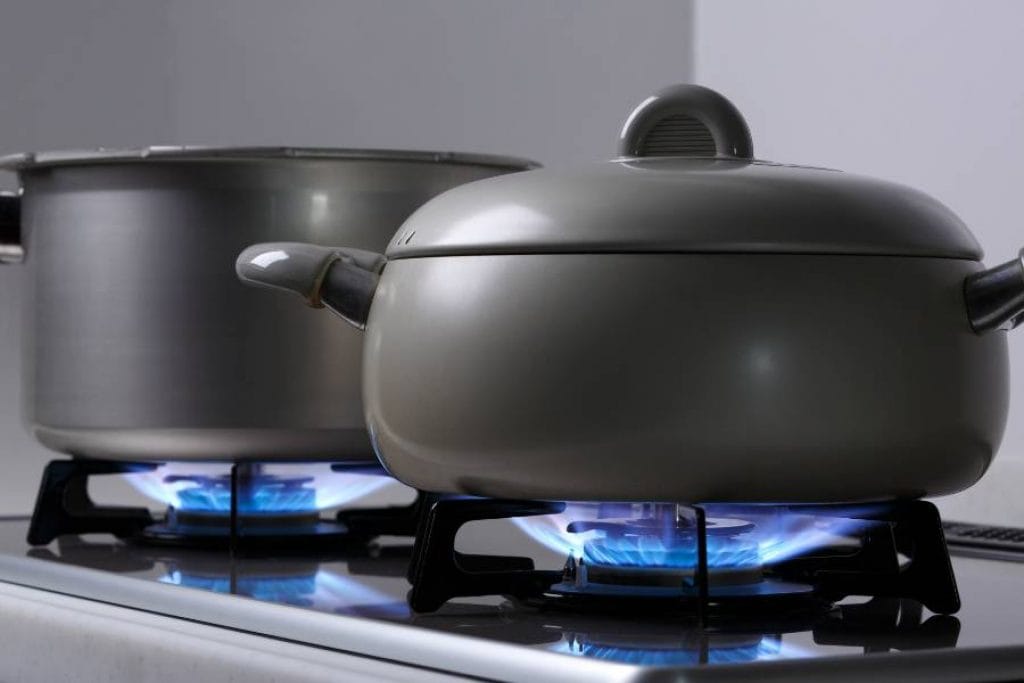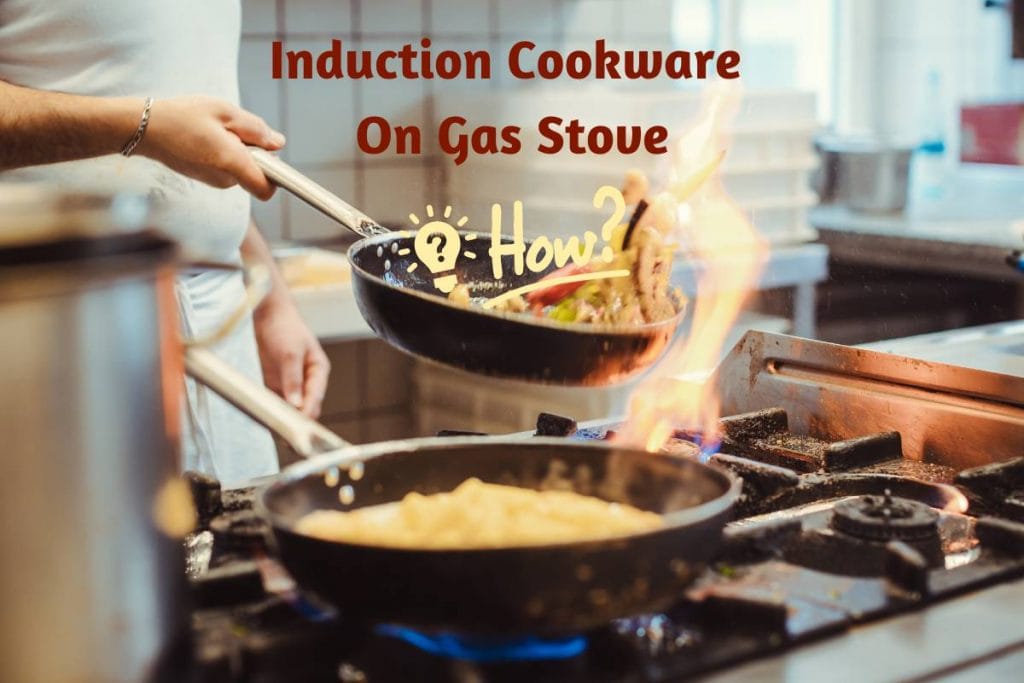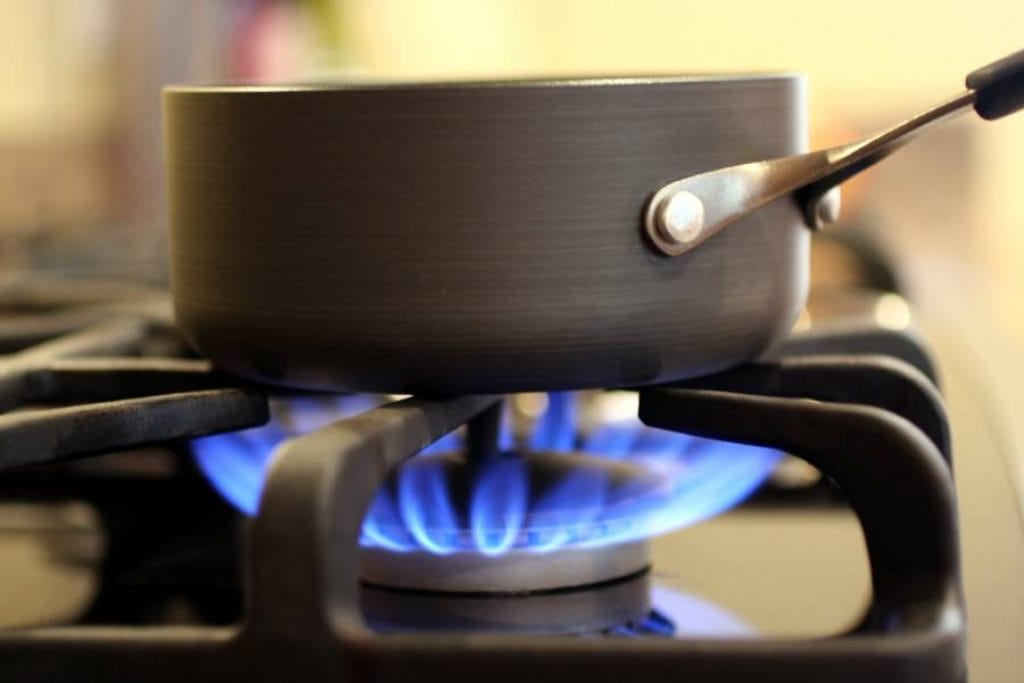Induction cookware is slightly different in design compared to traditional cookware manufactured for use on gas stoves. Considering most types of cookware can’t be used on induction stoves, it’s natural to wonder if induction cookware can be used on the gas stove.
Well, gas stoves are one of the most versatile cooking appliances and can accommodate almost any utensil, including induction cookware.
However, there might be some limitations, which I’ll have described later in this article. Read on to learn more about the compatibility of induction cookware with gas stoves.
How Is Induction Cookware Different From Traditional Cookware?
Induction cookware differs from the traditional ones on two main grounds: ferromagnetic metal material that is capable of electromagnetic induction and flat base. Let’s explore each of them.

Ferromagnetic Material
When you use traditional gas or electric stove, the appliance first heats up. In the subsequent stage, it transfers the heat that you put on the burner.
On the other hand, ferromagnetic induction cookware works on the principle of electromagnetic induction. All induction stoves come with a copper coil, capable of generating a magnetic field on the application of electricity. This magnetic field induces eddy current on the ferromagnetic cookware material, which is responsible to heat it up.
The prime benefit of using an induction stove is its energy efficiency. When you use a traditional gas or stove, a part of the heat gets transferred to the air around the pot. This is ultimately a waste of energy, and you end up paying for the fuel unnecessarily.
Ferromagnetic materials generate heat only on the cookware, not the air on top of it. This significantly reduces the possibility of burn injuries as well.
Flat Base Cookware
Unlike traditional cookware made of aluminum or iron, induction cookware comes with a completely flat base to increase the area of electromagnetism. This also makes it much easier to maintain and clean these appliances.
The cookware does not contain any holes, perforations, or nooks on the surface. It prevents grease and food particles from getting caught on these surfaces. Besides, induction cookware can distribute heat evenly throughout the metal, unlike traditional cookware.
To become induction-ready, induction cookware must have flat bases. Otherwise, even if it is ferromagnetic, it won’t work well with induction cooktops. This is a major difference point between traditional cookware and induction cookware.

Can You Use Induction Cookware For Cooking On A Gas Stove?
Yes, you can use almost all induction cookware on a gas stove. However, you have two exceptions in this regard. In case you are using cookware with a very thin steel sheet at the base, you should refrain from using it on a gas stove. Secondly, if the base of your induction cookware has a non-stick layer outside, do not use it on your stove.
Some induction vessels also come with a magnetic layer sprayed outside them. These, too, are incompatible to be used on gas stoves. In both these circumstances, the open flame might release toxic fumes.
Some induction cookware comes with an external coating. On exposure to fire, this coating melts. As a result, the flat surface loses its shape. Later, when you try to use the vessel on an induction cooktop, it wouldn’t work. This explains why you would find specific instructions on branded induction cookware, advising you not to use them on a gas cooktop.
Apart from the two situations I have just explained, you can use induction cookware with a metal or enameled surface safely on a gas cooktop. Many recommend using the same cookware for both types of cooktops.
Advantages Of Induction Cookware
Economic Option
The prime advantage of using induction cookware on gas stoves is the liberty to use different types of cooktops in your kitchen. Regardless of your heat source or fuel, you can use the same vessel on both gas and induction cooktops. In the end, this saves you money as you need not purchase separate pots or vessels for two types of cooktops.
High Heat Retention Capability
Branded induction cookware comes with thick stainless metal sheets at the bottom. This helps in heating up the metal quickly, and it retains the heat pretty long. Compared to traditional cooking vessels, induction cookware would retain the heat for a longer duration. So, you would require less fuel to cook the food.
Better Heat Distribution
Even when you use induction cookware on a gas stove, the utensil distributes the heat evenly everywhere. This, too, fosters faster and better-quality cooking. Ultimately, better heat distribution means shorter cooking time.
Corrosion-resistant And Easy To Clean
If you are done with stubborn food stains on traditional cookware, it’s time to get some induction vessels for your gas oven. Apart from being stainless, the cookware is amazingly easy to clean. So, you can easily remove the ugly stains from the vessels.
Limitations Of Using Induction Cookware On Gas Stove
Can Generate Toxic Fumes
As I have mentioned earlier, exposing an induction vessel with sprayed exterior or external coating directly to fire might release obnoxious fumes. This might not be too good for your health or the environment.
Warping Of The Vessels
In case the base or sides of the induction vessel are too thin, it might not endure the extreme heat of the flames. In these cases, the vessel would warp, rendering it useless on induction cooktops.
Deformation of Cookware
Some induction cookware comes with a magnetic spray on the exteriors. Using such vessels on a gas oven leads to the deformation of the vessel. In these cases, too, the cookware would no longer be compatible with induction cooktops.
Possibility of Contamination
In induction cookware, the non-stick layer contains some chemicals that are harmful to humans. During cooking, extreme heat might lead to the leaching of these chemicals into the dish. Ultimately, you would be consuming the contaminated food.

How To Use Induction Cookware On A Gas Stove?
With proper care and precaution, you can use induction cookware on your gas stove. Firstly, be vigilant enough to read special instructions on the cookware before proceeding. Here’s how you should cook on a gas stove using induction cookware.
- Keep the heat setting on your burner to medium or low. Since the thick metal base absorbs heat quickly, you won’t need a high heat setting too often.
- Use warm soapy water to wash the induction vessel gently before cooking. Use it only when it becomes completely dry.
- Never leave an empty induction pot on your gas or stove. In case you haven’t put the food on it, the vessel might sustain heat damage.
- In case you have just finished cooking on an induction vessel, don’t immerse it directly in cold water. The sudden temperature difference can lead to the warping of the material. Dip the vessel in lukewarm water first before cleaning the same.
Tips To Use Induction Cookware On Gas Stove
- It would be wise to select your induction cookware from a reputed brand to prevent possible damage. This turns out to be a cost-effective option as well, given that you can use the same vessel on gas as well as an induction cooktop.
- Make sure to use heavy-bottomed and thick-walled induction cookware if you are planning to cook on gas. This ensures that the cookware can resist the flame’s heat. With quality induction cookware, the vessel won’t warp and distribute the heat on a gas oven uniformly to the food.
- Before using an induction cookware on gas stove, ensure that it does not have any external coatings or spayed exterior surface which can be damaged on the application fire and heat.
Different Cookware Materials For Gas And Induction Stoves
- Stainless Steel: Stainless steel is compatible with gas stoves. However, it depends when it comes to induction stoves. The cookware would be compatible in case there’s a magnetic-grade stainless steel layer at the base of the pan. Otherwise, the base would require an induction plate to work.
- Aluminum: Aluminum vessels are compatible with gas ovens, but not with induction cooktops. To make them compatible with the latter, the base would need a magnetic layer.
- Cast iron: Cast iron is compatible with both gas and induction stoves. The presence of ferrous particles makes the process even more effective.
- Brass: Brass pans are good for use on gas stoves due to their high heat conductivity. On the other hand, they are not compatible with induction cooktops unless the manufacturers integrate the base with a ferrous layer.
- Copper: Copper being a good heat conductor, works fine with gas ovens. However, they are not good to use, along with induction cooktops.
- Ceramicware and Graniteware: Both Ceramicware and graniteware are compatible with gas ovens. However, they are not magnetic materials, which makes them incompatible with induction cooktops.
- Clay: Clay pots are compatible with gas ovens but not with induction cooktops. However, you should know how to cook in a clay pot on your gas stove. However, you cannot cook in these vessels on an induction cooktop. The reason is it is difficult to embed a layer of iron at the base of the clay vessel.
In Conclusion
Induction cookware is more versatile when it comes to utility. However, this shouldn’t imply that you can use any induction vessel on your gas stove. As I have explained, using the wrong method in terms of heat setting might lead to warping or even contamination. Try to choose branded induction cookware with a thick layer of metal at the base. This way, you can use the same vessel on different cooktops.
It makes sense to purchase induction cookware along with an induction cooktop for your kitchen. This is a cleaner, eco-friendlier, and cheaper cooking option that reduces fuel wastage. Besides, induction cookware can pacify the cooking process, releasing you of your household chores faster!

